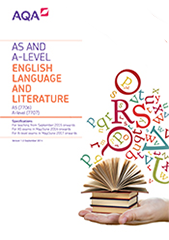Scheme of assessment
Find past papers and mark schemes, and specimen papers for new courses, on our website at aqa.org.uk/pastpapers
This specification is designed to be taken over two years, with all assessments taken at the end of the course.
A-level exams and certification for this specification are available for the first time in May/June 2017 and then every May/June for the life of the specification.
This is a linear qualification. In order to achieve the award, students must complete all exams in May/June in a single year. All assessments must be taken in the same series.
Our A-level exams in English include questions that allow students to demonstrate their ability to:
- draw together their knowledge, skills and understanding from across the full course of study
- provide extended responses.
All components offer only extended response questions.
All materials are available in English only.
Aims
Courses based on this specification must encourage students to develop their interest in and enjoyment of English as they:- develop and apply their knowledge of literary analysis and evaluation
- develop and apply their understanding of the concepts and methods appropriate for the analysis and study of language
- use linguistic and literary approaches in their reading and interpretation of texts, showing how the two disciplines can relate to each other
- engage creatively and critically with a wide range of texts
- explore the ways in which texts relate to each other and the contexts in which they are produced and received
- develop their skills as producers and interpreters of language
- develop their interest in and enjoyment of English as they undertake independent and sustained studies to develop their skills as producers and interpreters of language.
Assessment objectives
Assessment objectives (AOs) are set by Ofqual and are the same across all A-level English Language and Literature specifications and all exam boards.
The exams and non-exam assessment will measure to what extent students have achieved the following assessment objectives.
- AO1: Apply concepts and methods from integrated linguistic and literary study as appropriate, using associated terminology and coherent written expression
- AO2: Analyse ways in which meanings are shaped in texts
- AO3: Demonstrate understanding of the significance and influence of the contexts in which texts are produced and received
- AO4: Explore connections across texts, informed by linguistic and literary concepts and methods
- AO5: Demonstrate expertise and creativity in the use of English to communicate in different ways.
Weighting of assessment objectives for A-level English Language and Literature
| Assessment objectives (AOs) | Component weightings (approx %) | Overall weighting (approx %) | ||
|---|---|---|---|---|
| Paper 1 | Paper 2 | Non-exam assessment | ||
| AO1 | 16 | 6 | 6 | 28 |
| AO2 | 8 | 14 | 6 | 28 |
| AO3 | 12 | 4 | 4 | 20 |
| AO4 | 4 | 4 | 4 | 12 |
| AO5 | - | 12 | - | 12 |
| Overall weighting of components | 40 | 40 | 20 | 100 |
Assessment weightings
The marks awarded on the papers will be scaled to meet the weighting of the components. Students’ final marks will be calculated by adding together the scaled marks for each component. Grade boundaries will be set using this total scaled mark. The scaling and total scaled marks are shown in the table below.
| Component | Maximum raw mark | Scaling factor | Maximum scaled mark |
|---|---|---|---|
| Paper 1: Telling Stories | 100 | x1 | 100 |
| Paper 2: Exploring Conflict | 100 | x1 | 100 |
| Non-exam assessment: Making Connections | 50 | x1 | 50 |
| Total scaled mark: | 250 |
Non-exam assessment marking criteria
Investigation
AO1
AO1: Apply concepts and methods from integrated linguistic and literary study as appropriate, using associated terminology and coherent written expression.
|
Level |
Mark |
Students are likely to |
|---|---|---|
| 5 |
13–15 |
|
| 4 |
10–12 |
|
| 3 |
7–9 |
|
| 2 |
4–6 |
|
| 1 |
1–3 |
|
| 0 |
0 |
Offer no account of literary and non-literary material and/or secondary reading. |
AO2
Updated
AO2: Analyse ways in which meanings are shaped in texts.
|
Level |
Mark |
Students are likely to |
|
|---|---|---|---|
| 5 |
13–15 |
|
|
| 4 |
10–12 |
|
|
| 3 |
7–9 |
|
|
| 2 |
4–6 |
|
|
| 1 |
1–3 |
|
|
| 0 |
0 |
Offer no analysis of how meanings are arrived at. | |
AO3
AO3: Demonstrate understanding of the significance and influence of the contexts in which texts are produced and received.
|
Level |
Mark |
Students are likely to |
|---|---|---|
| 5 |
9–10 |
|
| 4 |
7–8 |
|
| 3 |
5–6 |
|
| 2 |
3–4 |
|
| 1 |
1–2 |
|
| 0 |
0 |
Offer no account of context whatsoever. |
AO4
AO4: Explore connections across texts, informed by linguistic and literary concepts and methods.
|
Level |
Mark |
Students are likely to: |
|
|---|---|---|---|
| 5 |
9–10 |
|
|
| 4 |
7–8 |
|
|
| 3 |
5–6 |
|
|
| 2 |
3–4 |
|
|
| 1 |
1–2 |
|
|
| 0 |
0 |
Offer no exploration of connections across texts. | |
- they write about only one text, either literary or non-literary
- they write about two texts but both are literary (eg no non-literary material is studied)
- they write about two texts but both are non-literary (eg no literary material is studied).
